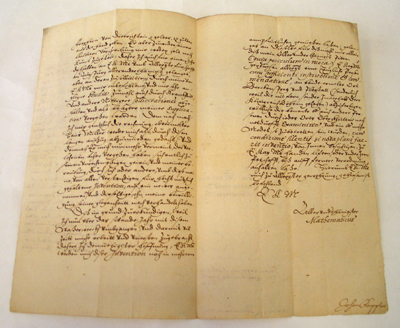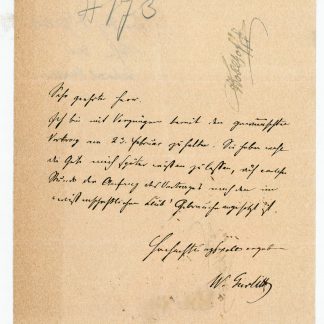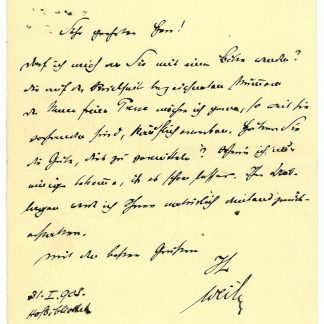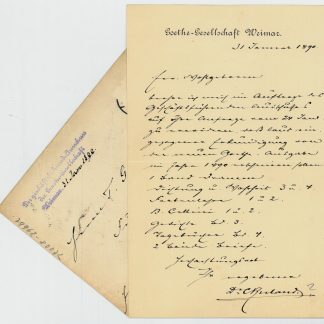[SOLD]
This item has sold. We are always interested in acquiring another copy or any item of comparable quality.
Of the utmost rarity
Letter signed. Petition to Emperor Rudolf II.
4to. 3 pp. With address and sender's rubric ("Johann Kepplern Mathematici gehorsamistes supplicirn. 22 Xber [1]604 Periculum in mora") on reverse. Slight stain.
Includes: Rudolf II, Emperor (1576-1612). LS. Prague, 31 Dec. 1604. 4to. 1½ pp. With papered seal and insignificant defects.
Important, hitherto unknown document of the great astronomer, concerning his only invention, the latterly so-called gear pump which remains in use to this day. For a discussion of Kepler's original device, which uses the meshing of gears to pump fluid by displacement, cf. Frank D. Prager (see below). Beyond Prager's discussion, the present petition to Emperor Rudolf II provides detailed insights into the genesis, financing, and manufacture of the invention, at the same time constituting an early document on issues of patent copyright and the protection of intellectual property: "[...] I duly report to Your Imperial Majesty that today I was informed by Gebhard Rösch, a miner from the Brocken area, that one of his diggers, Christoff Stampffer, upon his recent visit to Bleistadt [in the Ore Mountains, now Oloví in the Czech Republic] saw a skillfully constructed waterworks in the possession of one Veitt Richter. This device squirts the water high by means of simple rotation, which amazed him: and he, Gebhard Rösch, was able to gather from all that Stampffer could tell him that this machine apparently was a model of that wooden waterworks which he had seen at my place two or three years ago and which was recently rebuilt in brass by Jost Byrgius for Your Imperial Majesty. The said Stampffer was also told that this machine came from Augsburg and that two more of the kind were built there: one for the Duke of Wuerttemberg, the other for the Duke of Braunschweig. Two years ago I entered into a contract with Hans Miller, an Augsburg fountain builder, regarding the construction of this model and paid him 27 fl. of my own money and that of the Honourable Ludwig Baron Dietrichstein; yet I never received the works nor was I returned the money, in breach of contract. I wrote to Your Imperial Majesty in this matter a year ago, asking for intercession in Augsburg, but was so preoccupied with the studies which Your Majesty ordered me to carry out (and which are most convenient to me), as well as with illness and other, more urgent solicitations, that I was prevented from submitting the said request and forgot about it. I now conclude that the said Hans Miller has been trying to wear me out by this long interval, and as he believes I must by now have forgotten all about my lost things, he finally has appropriated my invention, deemed most useful by all judicious men, aiming to enrich himself and rob me of my dues, reproducing it alone or through others without my permission. I request that this matter be examined in detail, as I have spent more than seven years with the construction of this waterworks and have invested much time, effort, labour, and great expense therein [...]". Kepler proceeds to request the Emperor to forbid extraneous use of his machine in Bohemia.
Although Johannes Kepler is generally regarded as a purely abstract thinker and a much-quoted history of experimental physics (Gerland/Traumüller) even claims that nothing is known of any Keplerian experiments or apparatus, Kepler took a lively interest in scientific instruments (especially sectors and astronomical telescopes) and tried his hand at designs of his own. His gear pump, first conceived in 1597 upon reading della Porta's "Magia Naturalis" and properly worked out some three years later, was his only original design to reach the phase of construction and exploration. On 24 Oct. 1602, Kepler entered into a contract (preserved in the Pulkow Mss., vol. V, fol. 254) with Hans and Balthasar Miller of Augsburg, who were bound to deliver a model within two months and to return any funds not expended. After they failed to deliver, a further model was made by the Prague watchmaker Jost Buergi in 1604. It "is described as an 'amusing little fountain' which produces a water jet 'of quite some height'. Kepler was not however able to find a commercial use for his pump" (Neumaier, 392f.). It is revealing to note that Kepler, upon learning that counterfeits of his invention had been sent to the Dukes of Württemberg and of Braunschweig, immediately applied to the former, recommending himself as the inventor of a new sort of pump, as he had been told that the Duke took an interest in such amusements (Coll. Works, vol. 15, letter no. 314). On 17 February 1605, Ludwig von Dietrichstein, Kepler's co-financer in the pump venture, whom the astronomer apparently had informed of his misfortune, comforted his friend: "That others in the Empire should have taken the liberty of replicating your pump I will readily believe. However, they are bound by equity to seek a settlement with you. I assume it must have gotten out through that wicked little man in Augsburg, to whom you entrusted the works" (Coll. Works, vol. 15, letter 329).
Ultimately, the machine turned out to be unsuitable for its intended purpose of draining mines, as the water's sandy admixtures corroded the cogs. Also, it proved difficult to turn an invention into a viable commercial enterprise; two attempts made with the help of friends (in 1607 and 1623) failed. Yet the gear pump continued to be improved by other hands, and while the pumping of water is now the domain of centrifugal pumps, gear pumps remain in use for creating hydraulic or pneumatic pressure for the transmission of meter pulses and are a part of air compressors (in Diesel motors, e. g.) and laboratory vacuum machines.
The present letter was so far entirely unknown. The edition of Kepler's letters in the Collected Works contains several mentions of the astronomer's work on his pump, for the most part very brief (cf. especially vol. 14, letter 242 to Herwart von Hohenberg, 12 Jan. 1603, extant in a ms. copy only). Among them is also the undated draft of a similar letter to Rudolf: in it, Kepler complains about Miller's idleness and requests the Emperor to speed the fountain builder's work. While the editor of the Collected Works dates it at the "end of 1604", it is obviously the unsent request for intercession mentioned in the present letter and thus must have been written in 1603. Our missive, however, clearly reached its addressee: in the included letter by Rudolf II, the Emperor acts upon Kepler's request, ordering Nicholas May, captain of St. Joachimsthal (to which Bleistadt was subject), to have the machine used by Veit Richter in the Bleistadt mines examined and, if it should indeed turn out to be a plagiarism, to have it seized.
Full transcription included. Autographs by Kepler are of the utmost rarity.
Frank D. Prager, "Kepler als Pneumatiker und Erfinder der Zahnrad-Pumpe", in Blätter für Technikgeschichte 28, 1966, p. 121-137. Robert Neumaier, Hermetic pumps: the latest innovations and industrial applications of sealless pumps. Houston, TX, Gulf Publ., 1997, p. 392f. (with fig. 4.3). Cf. Johannes Kepler, Gesammelte Werke. Vol. 15: Briefe 1604-1607. Munich, Beck, 1951, no. 313 (autogr. draft: "Prague, end of 1604". Pulkowo Observatory, Kepler-Mss. vol. V, fol. 210).





